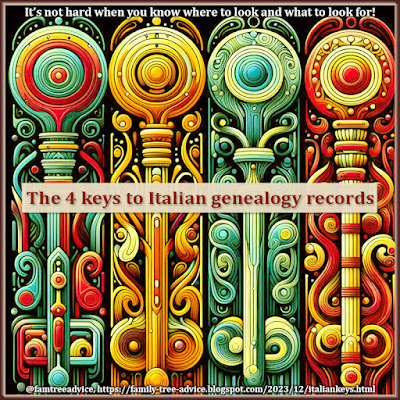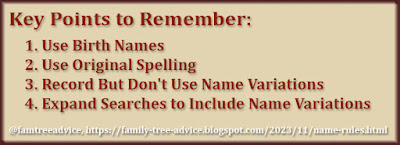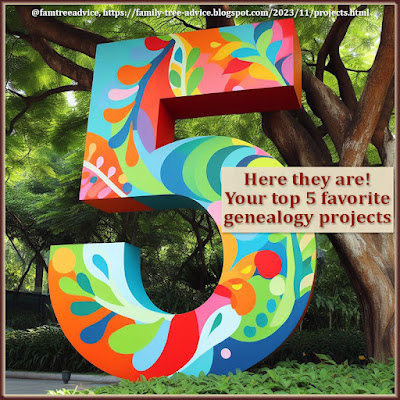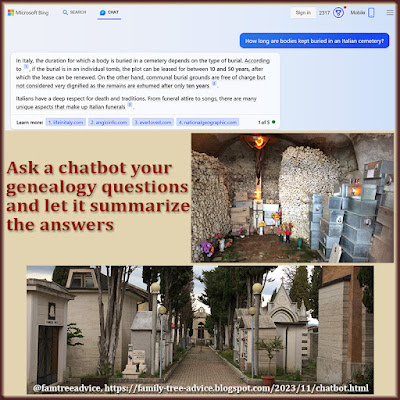I've learned so much by spending countless hours immersed in Italian vital records. If you're new to Italian genealogy research, I can save you those countless hours.
Here are the 4 keys to help you build your Italian family tree.
 |
| Here's your crash course in Italian genealogy documents. Use these 4 keys to build your family tree. |
1. Location and Mobility
To find Italian vital records, you must know where your people came from. Not all records are searchable in one convenient form. And without the town name, you can't be sure you've found your person or someone with the same name. Records are stored by town name and held in the provincial capital's archives. The town name is your first hurdle. Read "4 Key Places to Discover Your Ancestor's Hometown."
Until the 1890s, most Italians stayed in or near their hometown for generations. It isn't as if a man could meet a woman who lived hours away and marry her. You must expect that your ancestral couples lived in the same town or neighboring towns. There were no highways and travel wasn't easy.
When a couple from different towns married, they were likely to marry in the woman's town but live in the man's town. A man could inherit property, so they lived in the man's home—which may include other members of his family.
Tip: If your couple married in Italy, expect them to have been born in the same town or neighboring towns.
2. Language Is NOT a Barrier
There's no reason on earth to let the Italian language stop you from reading a vital record. The documents follow standard patterns. And you don't need to translate every single word. What you want to find are:
- Names don't need translation. They are exactly what you see in the document. There's no reason you can't spot the name you're looking for in a document.
- If a last name is hard to decipher, type what you think you see into the Cognome box on the Cognomix website. As you type, you'll see suggestions of actual names. Once you click Cerca (Search), you'll see where you can find that name in Italy. https://www.cognomix.it/mappe-dei-cognomi-italiani
- Another option: Type a last name into Ancestry and FamilySearch to see suggestions.
- Place names (both town names and street names) don't need translation.
- If you found your document on a genealogy website, the website should tell you the town name.
- If you received the document another way, the town name is on the document. Look close to the top of the document, often after the words Comune di (town of).
- If the comune name is hard to read, use this alphabetical list of Italian towns and try to match what you see. http://en.comuni-italiani.it/alfa
- Street names may no longer exist in your ancestral town. But if you want to have a look, use Bing Maps rather than Google Maps. It has more street names than Google in Italian towns. https://www.bing.com/maps
- Some street names begin with the word Contrada. A contrada is more of a neighborhood name. It can be a large area with only one road running through it. That road name will usually be the Contrada name. These are easiest to find on the map because they're well outside the town center.
- Dates do need translation, but there is one terrific resource to help you out. The FamilySearch Wiki has month names, numbers, and other key genealogical word translations. https://www.familysearch.org/en/wiki/Italian_Genealogical_Word_List
- On most Italian vital records, you'll see numbers written out in longhand, not numerals. That includes years. With practice, seeing mille ottocento ventiquattro instead of 1824 is no problem.
- Vital records begin with the date someone wrote the document. That means the event may have happened earlier. On a birth record, look further down for the (often pre-printed) words nel giorno (on the day) and del mese di (of the month of). If you see nel giorno sette del mese di Gennaro, you'll know the person was born/died on the 7th day of January. (Check the FamilySearch Wiki linked above for numbers and months.)
- Birth records often have a separate column for the baptism. This may include a church or parish name. You can look up a church name by location using this website: https://italia.indettaglio.it/eng/parrocchie/parrocchie.html. You may get the street address of the church, too.
- The baptism column can be confusing because it can have up to 3 dates. Look for the earliest date, and that's the baptism. The format: On this date(1) the church notes that on this date(2) we recorded that on this date(3) we baptized this baby. Wacky, yes, but look for the earliest date.
- Marriage records often have a separate column, too. In the smaller column you'll find the date and place of the church wedding. It's often later than the date at the top of the main column. I record the main column's date as the marriage license. On this date, the couple was married in the civil sense. Afterward, they married in the church.
3. Where to Find the Facts
We've just explored the different types of names, dates, and places you'll find on vital records. Now let's dive deeper so you know exactly what to expect to find. The standard forms used in your ancestral towns will change over time, but the basics are the same. (In my towns, the 1866–1873 documents are all in longhand. That's why it's important to know what to expect.)
- Birth records. The basic format is:
- On this date, before the mayor (look for the word Sindaco) of this town, appeared (look for the word comparso) FATHER of baby (and maybe his father's name), age, profession, residence (look for the word domiciliato) to present a baby (bambino is a boy, bambina is a girl).
- Next, sometimes written entirely in longhand, you'll see MOTHER of baby, age, profession. The word moglie (wife) tells you that the father and mother are legally married.
- Next is the date of birth (nel giorno _____ del mese di _____), followed by the baby's name.
- Look for a baptism date in a separate column or sometimes written briefly in the margin.
- Marriage records. These begin the same way as a birth record, with the date, mayor, and town. Then comes the important stuff:
- After the word comparsi, look for GROOM's name, age, place of birth (nato in), profession, and residence.
- The groom's parents come after the words figlio di (son of). You'll find his father's name, occupation, and residence, and if he's dead, you'll see the word fu (was) before his name. Then you'll find his mother's name, sometimes her profession, and her residence. If you're very lucky, you'll get the parents ages and maybe their dates of death.
- Next comes the BRIDE whose name comes after the word e (and). Look for her age, place of birth, and residence.
- After the words figlia di (daughter of), look for her parents in the same format as the groom's parents above.
- Look for the date and place of the church wedding in a separate column.
- Death records. After the date of the document, the mayor's name, and the town name, death records usually list 2 witnesses. You can look for familiar last names or relationship words (avo=grandfather, zio=uncle), but there may be no relationship. The important facts begin after the witness information.
- Look for the words che nel giorno (that on the day). What follows is the day and month of death.
- If it says é morto(a) nel(la) casa propria, you know this person died in their own home (casa propria). Use these words as a clue to the person's gender if you're unsure. Morto nel casa propria means it's a male. Morta nella casa propria means it's a female.
- If you don't see the words casa propria, they died somewhere else—like in someone else's house. Don't let that extra name of the homeowner confuse you. If it starts with nel casa di (in the house of) then the following name should be the homeowner, followed by the deceased's name.
- Look for the deceased's name written in longhand. It may also say they were the husband (marito) or wife (moglie) of the following name.
- Next look for the deceased's age (di anni _____), place of birth (nato di _____), profession, residence, and their father and mother's names, professions, and residence.
For diagrams showing where to find the facts on Italian vital records, see:
- How to Read an Italian Birth Record
- How to Read Italian Marriage Records
- How to Read an Italian Death Record
Unless there's a handwritten paragraph after that, then you've found the facts you need. Sometimes an extra paragraph will explain important facts such as:
- The father didn't report the birth because he was ill, out of the country, or he died on this date.
- The child in this birth record married this person on this date. This is a treasure written in some empty space on a birth record.
- The baby's birth was legitimized by the marriage of its parents on this later date.
- This man died leaving several minor children, and here are their names and ages.
If you see a long handwritten paragraph on your document, look for keywords like:
- matrimonio (marriage)
- morto (death)
- figli minori (minor children)
- ammalato (ill)
- lontano dal paese (far from the country)
Use the FamilySearch Italian Genealogical Word List and Google Translate to see if you've found useful information or standard boilerplate.
4. Naming Conventions
Different cultures have different standards for what to name the baby. Keep in mind, these could be more guidelines than rules. Many of my own ancestors completely ignored the naming conventions. In general:
- The first male is named after his paternal grandfather.
- The second male is named after his maternal grandfather.
- The first female is named after her paternal grandmother.
- The second female is named after her maternal grandmother.
But here are more naming conventions to look for:
- If a baby is born after their father dies, the baby is named after the father. A baby girl may receive a female version of her father's name, such as Francesca if her father was Francesco.
- Say a person becomes a widow and then remarries. Their next child is named after the deceased spouse. This is a good way to confirm that you've found the remarriage of a particular man or woman.
- When a child dies, the parents usually give the next child of the same sex the same name as the deceased child. You may find birth records for 2, 3, or 4 siblings with the same exact name. If you do, then you can assume each one died before the same-named sibling was born. This comes in handy if death records are not available.
Tip: A set of marriage documents may use the birth record of a same-named deceased sibling. This is just human error.
In my towns, I've seen families wait until baby-boy #4 before using the paternal grandfather's name. And many families never get to the 4th grandparent's name. This may be a regional practice since all my ancestors came from neighboring towns. Maybe the naming rules were less strict there. Keep an open mind and don't rule someone out because they don't have the name you'd expect.
When you find a marriage record and the groom came from another town, search that town for their kids. Any time you learn your person's parents' names, you can expand your search. You can search for the previous generation's birth, marriage, and death records, if the years are available. Read "How I Tracked Down My 4th Great Grandmother's Parents."
That's the beauty of Italian vital records. Each one you find for someone in your family tree can lead to more and more generations. You now have the keys. As long as records are available for your towns, there's no stopping you.






